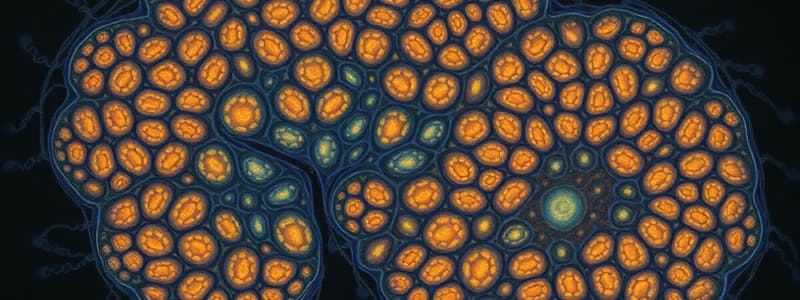Podcast
Questions and Answers
What type of endoplasmic reticulum is primarily involved in protein secretion?
What type of endoplasmic reticulum is primarily involved in protein secretion?
- Transitional endoplasmic reticulum
- Cytoplasmic reticulum
- Smooth endoplasmic reticulum
- Rough endoplasmic reticulum (correct)
Which of the following statements best describes the primary function of the smooth endoplasmic reticulum (SER)?
Which of the following statements best describes the primary function of the smooth endoplasmic reticulum (SER)?
- Ribosome attachment and protein folding
- Lipid synthesis and drug detoxification (correct)
- Protein secretion and transport
- Protein synthesis and ribosome production
Where do transport vesicles originate from?
Where do transport vesicles originate from?
- Smooth endoplasmic reticulum
- Golgi apparatus
- Nuclear membrane
- Rough endoplasmic reticulum (correct)
What structure do the proteins exit the Golgi apparatus from in the form of secretory vesicles?
What structure do the proteins exit the Golgi apparatus from in the form of secretory vesicles?
Which types of vesicles are transformed from proteins entering the Golgi apparatus?
Which types of vesicles are transformed from proteins entering the Golgi apparatus?
What is the primary role of ribosomes found on the rough endoplasmic reticulum?
What is the primary role of ribosomes found on the rough endoplasmic reticulum?
What occurs at the cisternae of the rough endoplasmic reticulum (RER)?
What occurs at the cisternae of the rough endoplasmic reticulum (RER)?
How do secretory vesicles assist in cell membrane renewal?
How do secretory vesicles assist in cell membrane renewal?
Flashcards are hidden until you start studying
Study Notes
Endoplasmic Reticulum (ER)
- A continuous, branching membrane system within the cytoplasm.
- Connects the nuclear membrane and is continuous with the plasma membrane.
- Facilitates the transport of chemicals between the nucleus and cytoplasm.
Types of Endoplasmic Reticulum
-
Rough Endoplasmic Reticulum (RER):
- Contains ribosomes, giving it a granular appearance.
- Abundant in cells specialized for protein secretion, like pancreatic cells.
- Plays a key role in protein synthesis.
- Amino acids are assembled into polypeptide chains on ribosomes.
- Polypeptide chains enter the RER cisternae.
- Proteins are condensed and packaged into transport vesicles at the RER's end.
- Transport vesicles deliver proteins to the Golgi apparatus.
-
Smooth Endoplasmic Reticulum (SER):
- Composed of branched tubules with a smooth membrane (no ribosomes).
- Involved in:
- Lipid synthesis
- Drug detoxification
- Calcium distribution
Golgi Apparatus
- A membrane-bound organelle involved in protein processing and packaging.
- Varies in size depending on the cell type.
- Larger and more active in secretory cells.
- Smaller in cells with minimal secretory activity.
Structure of the Golgi Apparatus
-
Cisternae: Flattened, elongated sacs stacked parallel to each other.
- Trans face: Concave mature surface.
- Cis face: Convex immature surface.
-
Transport or Microvesicles:
- Small, rounded sacs filled with protein.
- Originate from the RER and fuse with the Golgi cisternae.
-
Secretory or Macrovesicles:
- Formed from microvesicles within the Golgi.
- Contain concentrated proteins, enzymes, and hormones.
- Different types of secretory vesicles:
- Excretory vesicles: Containing excreted enzymes and hormones.
- Excreted protein vesicles: Renewing cell membranes.
- Lysosomal vesicles: Containing lysosomal enzymes.
Studying That Suits You
Use AI to generate personalized quizzes and flashcards to suit your learning preferences.




